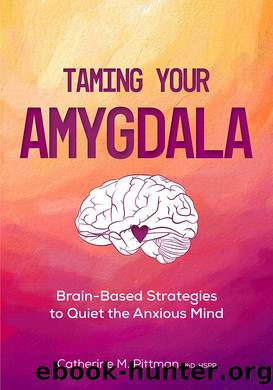Taming Your Amygdala by Pittman Catherine;

Author:Pittman, Catherine;
Language: eng
Format: epub
Publisher: PESI
Published: 2022-06-02T00:00:00+00:00
Chapter 9
How Your Amygdala
Creates Triggers
Up to this point, our focus has been on helping you better understand the amygdala and learn ways to manage how it functions. Although chapter 5 focused on the language of the amygdala, it didnât address one important aspect of communication: the language you need to learn so you can communicate new information to this part of your brain. Learning this language will allow you to teach your amygdala to respond differently.
The amygdalaâs ability to learn is what makes it so valuable to so many species of animals. The amygdala can learn to fear objects and situations as a means of protecting us from threats that didnât exist for previous generations or earlier in our lives. That is, it can adapt to the specific situation in which an animal lives. Consider a squirrel that has found a certain fenced-in yard filled with acorns. If the squirrel experiences a negative event in that yard, like being chased by a dog, then the squirrelâs amygdala will learn to react to the yard as if it is dangerous. It will produce the defense response whenever the squirrel approaches the fenced yard, preparing the squirrel to fight, flee, or freeze. This learning is not about logic, and it does not require cause and effect. The squirrel simply experienced the fenced yard and the dog at the same time.
In the same way, when you experience a negative event, your amygdala is likely to identify situations or objects that coincided with that event as dangerous. Thatâs because the amygdala is designed to learn from experience on the basis of association. When a certain location or object is associated (or paired) with a negative experience, the amygdala learns to respond to that location or object as dangerous by creating new neural connections in the brain associated with fear (Quirk et al., 1995).
Neurons, which are certain cells in the brain, form memories when two different neurons are activated at the same time (Hebb, 1949). You may have heard Carla Shatzâs famous phrase âneurons that fire together wire togetherâ (Doidge, 2007), which means that a memory is formed when a connection between neurons forms. In the case of the squirrel, two different sets of neurons began firing at the same time: the neurons that were processing the experience of being in the fenced-in yard and the neurons that were processing the experience of being chased by a dog. This caused the squirrelâs amygdala to create neural circuitryâthat is, to form an emotional memoryâthat associated the fenced-in yard with danger, causing the squirrel to respond with fear.
Download
This site does not store any files on its server. We only index and link to content provided by other sites. Please contact the content providers to delete copyright contents if any and email us, we'll remove relevant links or contents immediately.
Should I Stay or Should I Go? by Ramani Durvasula(7435)
Why We Sleep: Unlocking the Power of Sleep and Dreams by Matthew Walker(6363)
Fear by Osho(4496)
Flow by Mihaly Csikszentmihalyi(4493)
Rising Strong by Brene Brown(4195)
Why We Sleep by Matthew Walker(4193)
How to Change Your Mind by Michael Pollan(4115)
Too Much and Not the Mood by Durga Chew-Bose(4097)
The Hacking of the American Mind by Robert H. Lustig(4092)
Lost Connections by Johann Hari(3929)
He's Just Not That Into You by Greg Behrendt & Liz Tuccillo(3719)
Evolve Your Brain by Joe Dispenza(3506)
The Courage to Be Disliked by Ichiro Kishimi & Fumitake Koga(3264)
Crazy Is My Superpower by A.J. Mendez Brooks(3208)
What If This Were Enough? by Heather Havrilesky(3199)
Resisting Happiness by Matthew Kelly(3197)
Descartes' Error by Antonio Damasio(3168)
The Book of Human Emotions by Tiffany Watt Smith(3145)
In Cold Blood by Truman Capote(3140)
